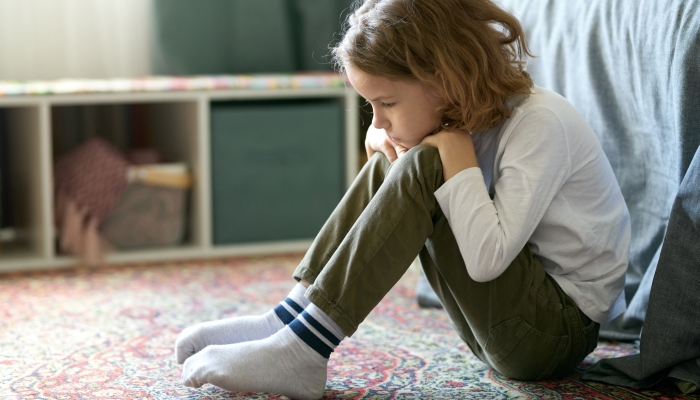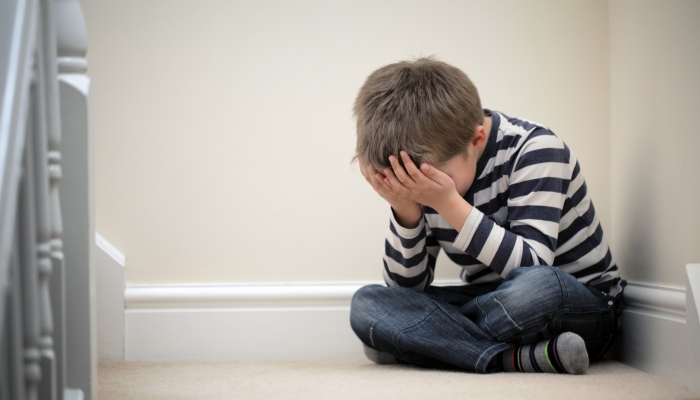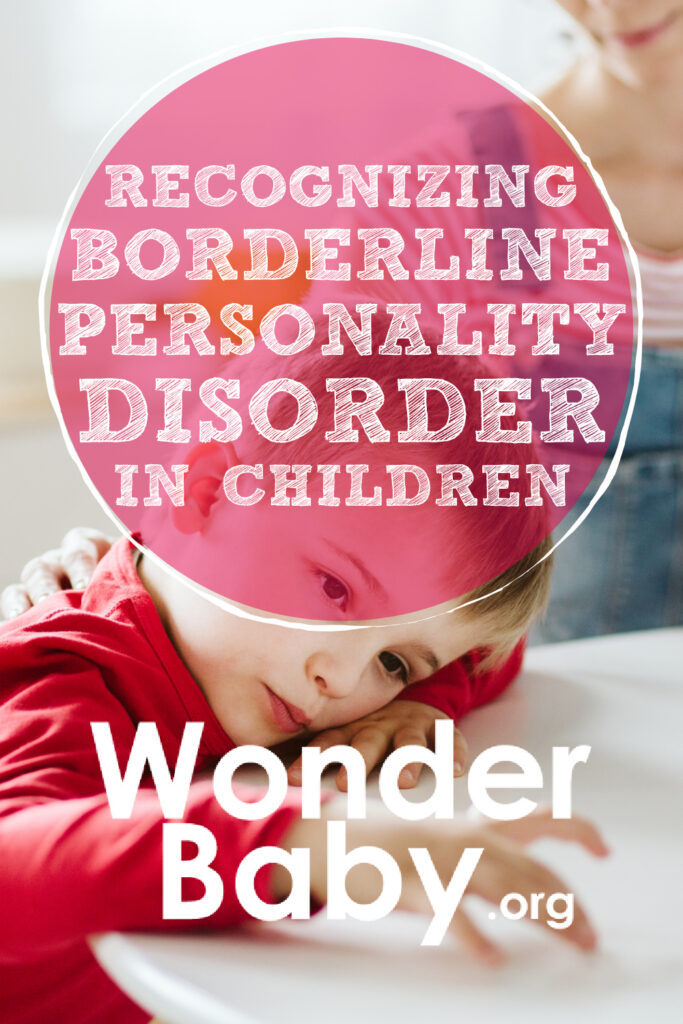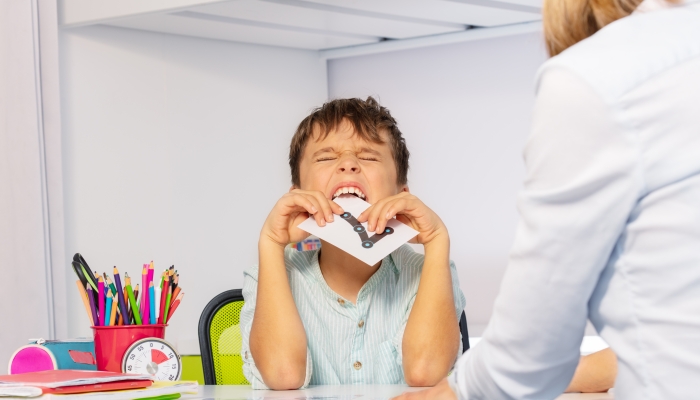Recognizing Borderline Personality Disorder in Children

- Genetics and environmental factors can be significant predictors of developing borderline personality disorder (BPD).
- BPD patients may have extreme emotions and emotional turmoil.
- Other mental health conditions can be confused with borderline personality disorder in children.
- A thorough evaluation is needed to accurately diagnose any type of personality disorder.
- Mental health professionals are valuable allies as you work through overwhelming emotions with your child.
Have you ever wondered if your child has a personality disorder?
Children and adolescents may experience big feelings as part of normal growth and development. Sometimes, how those feelings are processed emotionally, verbally, or physically can be…colorful. Or, as a therapist friend of mine says, spicy.
When your child’s behavior seems more extreme than expected, or symptoms are lasting longer than what you feel is normal, it may be time to enlist the help of a child mental health specialist to determine what is happening for your family member.
Personality disorders, such as borderline personality disorder (BPD), are typically diagnosed in adolescence or adulthood. However, you may start to see BPD symptoms long before a diagnosis arrives.
How can you recognize the differences between normal emotional reactions and a psychiatric condition like borderline personality disorder?
Causes and Risk Factors

Personality disorders, such as BPD, obsessive-compulsive disorder (OCD), or narcissistic personality disorder (NPD), are thought to be a result of both nature and nurture11. Mayo Foundation for Medical Education and Research. Personality disorders. Mayo Clinic. 2023. https://www.mayoclinic.org/diseases-conditions/personality-disorders/symptoms-causes/syc-20354463.
Said differently, genetic factors may set the stage, while the social and emotional environment a child grows up in raises the curtain.
Physical BPD risk factors include:
Genetic Predisposition
Family and twin studies22. Amad, A., Ramoz, N., Thomas, P., Jardri, R., & Gorwood, P.. Genetics of borderline personality disorder: Systematic review and proposal of an integrative model. Neuroscience & Biobehavioral Reviews. 2014;40, 6–19. https://doi.org/10.1016/j.neubiorev.2014.01.003 of people with a borderline personality disorder diagnosis have shown that other family members with the same genes have a relatively high risk (40%) of also developing the same mental health condition.
Other mental disorders that may predispose a child to develop BPD include:
- Anxiety
- Depression
- Eating disorders
- Bipolar disorder
- Other personality disorders (such as OCD or NPD)
- Substance abuse or substance use disorder
- Schizophrenia
Neurobiological Factors
Children and adults with borderline personality disorder also have brains that are structurally different from those without this condition.
Imaging studies, such as magnetic resonance imaging33. Lis, E., Greenfield, B., Henry, M., Guilé, J. M., & Dougherty, G. . Neuroimaging and genetics of borderline personality disorder: a review. Journal of psychiatry & neuroscience. 2007;32(3), 162–173. https://www.ncbi.nlm.nih.gov/pmc/articles/PMC1863557/#:~:text=MRI%20studies%20have%20demonstrated%20that,cortex%20and%20increased%20putamen%20volume. (MRI) and positron emission tomography44. Juengling, F. D., Schmahl, C., Heßlinger, B., Ebert, D., Bremner, J. D., Gostomzyk, J., Bohus, M., & Lieb, K.. Positron emission tomography in female patients with borderline personality disorder. Journal of Psychiatric Research. 2003;37(2), 109–115. https://doi.org/10.1016/s0022-3956(02)00084-5 (PET) scans, show differences in the limbic system55. The limbic system. Queensland Brain Institute – University of Queensland. https://qbi.uq.edu.au/brain/brain-anatomy/limbic-system and prefrontal cortex66. Arnsten, A. F.. Stress signalling pathways that impair prefrontal cortex structure and function. Nature Reviews Neuroscience. 2009;10(6), 410–422. https://doi.org/10.1038/nrn2648—areas of the brain that control behavioral and emotional responses and impulse control, respectively.
Environmental Factors
A key factor that determines if a child who is genetically susceptible to BPD will go on to develop this mental health condition is the type of emotional environment in which they are raised.
According to the Substance Abuse and Mental Health Services Administration77. Borderline Personality Disorder. SAMHSA. 2023. https://www.samhsa.gov/mental-health/borderline-personality-disorder, children who have experienced specific types of negative events may go on to develop later BPD symptoms.
These adverse social factors include:
- Abandonment in childhood or adolescence
- Childhood neglect (emotional or physical)
- Childhood maltreatment
- Child abuse (physical, mental, or emotional)
- Sexual abuse in childhood (thought to be a particularly significant predictor of BPD)
- Disrupted family life
- Neglect or separation from primary caregivers
- Poor communication in the family
Borderline personality disorder is thought to occur in susceptible children who have experienced stressful life events (leaving them vulnerable emotionally) and an emotionally unsupportive family environment.
However, it’s also important to realize that BPD may occur in children without a family history of mental health conditions and who live in a stable, supportive family structure.
Symptoms and Presentation in Children

Many young people experience periods of intense emotions, depressive symptoms, or other types of psychiatric symptoms throughout their childhood. However, these stormy periods don’t necessarily indicate that your child has borderline personality disorder.
One way to help determine what’s happening for your child is to give focused attention to their regular behavior.
By observing and recording your child’s emotional patterns and responses, it will be easier to determine if there’s an emerging mental health condition.
Children with borderline personality disorder symptoms tend to show volatility in the following areas:
Emotional Reactivity
While all people experience a normal range of emotions throughout their day, children with personality disorder symptoms, like BPD, tend to experience a higher emotional baseline88. Kuo, J. R., & Linehan, M. M.. Disentangling emotion processes in borderline personality disorder: Physiological and self-reported assessment of biological vulnerability, baseline intensity, and reactivity to emotionally evocative stimuli. Journal of Abnormal Psychology. 2009;118(3), 531–544. https://doi.org/10.1037/a0016392 (reactive emotional state).
Perhaps this illustration may help: Picture a wire with an electric current running through it. People with a generally regulated emotional state would be like a low voltage of electricity running through the cord. Something (like a bug) touches the wire. The current may flare up but returns to its regular gentle hum relatively quickly.
In folks with a higher emotional baseline, the cord is highly charged all the time, even though nothing has touched it. When something does come in contact with the wire, a big flare of energy occurs—which may require help from a parent or trusted adult to get back to their “normal” (higher) baseline state.
Emotional Dysregulation
Because people with borderline personality disorder have actual, documented changes in the area of the brain that manages behavioral and emotional responses, emotional regulation can be a real challenge.
Emotional dysregulation in children with borderline symptoms99. Carpenter, R. W., & Trull, T. J.. Components of Emotion Dysregulation in Borderline Personality Disorder: A Review. Current Psychiatry Reports. 2012;15(335). https://doi.org/10.1007/s11920-012-0335-2 can look like this:
- Emotion sensitivity
- Heightened, persistently negative emotions or mood
- Frequent mood swings (emotional instability)
- Lack of appropriate regulation strategies (looks like intense and disproportionate emotional reactions)
- Difficulty controlling emotions, especially anger
- An abundance of harmful regulation strategies (hitting, acting out, etc.)
Impulsivity
The prefrontal cortex is one of the main structures controlling impulsive behavior. Because this area is also affected in patients with this personality disorder, experts at the Child Mind Institute report that you might see these types of borderline symptoms1010. Quick Guide to Borderline Personality Disorder. Child Mind Institute. 2023. https://childmind.org/guide/quick-guide-borderline-personality-teens-young-adults:
- Difficulty in delaying gratification
- Abrupt, pronounced changes in goals and aspirations
- Engaging in risky behaviors (reckless driving, thrill-seeking, alcohol and/or substance abuse)
- Self-harm or self-destructive behaviors (cutting, suicidal behavior)
- Relational aggression (hitting others, being sarcastic, rude, or inappropriate)
Relationship Instability
One of the hallmark features of borderline personality disorder (BPD), according to experts at the Child Mind Institute, is an overwhelming fear of abandonment1111. Miller, C.. What Is Borderline Personality Disorder?. Child Mind Institute. 2023. https://childmind.org/article/borderline-personality-disorder, coupled with the equally strong and painful emotions of emptiness, shame, and self-loathing.
The intense pain of these feelings can cause problematic behaviors in family and peer relationships, which may manifest as:
- Misinterpreting minor social cues as “proof” of abandonment, with a pronounced, quick reaction creating relationship instability with friends, family, and others
- Intense attachment followed by abrupt detachment (splitting)
- Tumultuous relationships, even with close family or friends
- Excessive need for reassurance or signs that they are loved (may look like relentless texting, calling, begging, or clinging)
- Pervasive, long-term feelings of emptiness

Dissociative Symptoms
Mental health experts at the Mayo Clinic describe the term dissociative1212. Mayo Foundation for Medical Education and Research. Dissociative disorders. Mayo Clinic. 2023. https://www.mayoclinic.org/diseases-conditions/dissociative-disorders/symptoms-causes/syc-20355215 as a condition that involves “experiencing a loss of connection between thoughts, memories, feelings, surroundings, behavior, and identity.” The brain sometimes uses dissociative symptoms as a way to escape from events that are emotionally overwhelming, troubling, or painful.
Understandably, these can be scary for young people and their adults to witness.
Unexpected physical or emotional stress can heighten dissociative symptoms1313. Drescher, J.. What Are Dissociative Disorders?. Psychiatry.org. 2022. https://www.psychiatry.org/patients-families/dissociative-disorders/what-are-dissociative-disorders#:~:text=Dissociative%20symptoms%20can%20potentially%20disrupt,with%20previous%20experience%20of%20trauma. for BPD patients and present in ways like:
- Feeling detached from one’s body or mind (derealization)
- Feeling that surroundings are unreal or “living in a movie” (depersonalization)
- Paranoid thinking
- Loss of memory (amnesia)
- Hallucinations (auditory, visual, or tactile1414. Tactile hallucinations (formication): Causes & treatment. Cleveland Clinic. 2022. https://my.clevelandclinic.org/health/symptoms/23960-tactile-hallucinations-formication)
- Body image distortions
- Self-mutilation or self-harm during a dissociative episode
It’s very important to stay with your child and keep them as physically safe as possible when they are experiencing dissociative symptoms.
Identity Issues
Early adolescence is when young people begin the developmental task of identity formation. In other words, children start to separate from their parents as their primary source of self-identification and work to discover who they are as individuals.
For young people with borderline personality disorder, this developmental task can be especially tricky.
Identity issues in adolescence and early adulthood1515. Wilkinson-Ryan, T., & Westen, D.. Identity Disturbance in Borderline Personality Disorder: An Empirical Investigation. American Journal of Psychiatry. 2000;157(4), 528–541. https://doi.org/10.1176/appi.ajp.157.4.528 for these folks can look like this:
- Unstable self-image
- Unrealistic sense of self
- Persistent uncertainty about self-identity
- Inconsistencies in beliefs and behaviors
- Overidentification with groups or roles
- Possible difficulties in commitment to jobs, values, and goals
Because similar symptoms can occur between borderline personality disorder and other psychiatric conditions, it is vital to talk with a qualified mental health provider about your concerns.
The Complexity of BPD Diagnosis in Children

After reading about symptoms typically present in those with borderline personality disorder (BPD), you may wonder why more people—especially younger children—aren’t diagnosed with this condition.
It’s a fair question.
The key to the answer lies in the typical behavioral and developmental experiences of children.
Normal Childhood Development
Many parents have a loose understanding of the normal behavioral and developmental tasks of early childhood through adolescence. As children move through the various stages, the end goal is to become their own, autonomous person.
For some children, that road to independence can be bumpier than others.
Childhood Development and BPD
You may have noticed that BPD symptoms have a lot in common with other conditions, like attention-deficit-hyperactivity-disorder (ADHD) symptoms.
Among other conditions, BPD can look like disruptive mood dysregulation disorder (DMDD), oppositional defiant disorder (ODD), or separation anxiety disorder.
The key is that children and adolescents with BPD experience these symptoms as their normal, rather than exceptions (even in particularly long seasons.)
This is why medical and mental health professionals recommend sharing your concerns with your child’s pediatrician or other health professional. You and your child will need help sorting through the symptoms of behavioral dysregulation to figure out what’s happening inside your child’s mind.
The Controversy
Historically, borderline personality disorder (BPD) has been thought of as a condition that starts in late adolescence or early adulthood. Because the condition may not be fully seen because of developmental factors (and because psychiatric diagnoses tend to stay with children throughout their lives), many providers may not diagnose BPD—even if they suspect it’s present.
The current consensus and emerging research on BPD is that it can also be considered an adolescent condition.
According to the Diagnostic and Statistical Manual 5th Edition (DSM-5)1616. Biskin, R. S.. The Lifetime Course of Borderline Personality Disorder. The Canadian Journal of Psychiatry. 2015;60(7), 303–308. https://doi.org/10.1177/070674371506000702, an official diagnosis of borderline personality disorder (BPD) may be given if the symptoms have been consistently present for at least one year.
Concurrent Disorders

Did you know that it’s possible—at times, even likely—that a person who has a mental health condition is more likely to have other disorders?
Here is a list of other psychiatric conditions that commonly present alongside BPD in children:
| Condition | Concurrency rate |
| Anxiety disorders | Up to 90% |
| Attention deficit hyperactivity disorder (ADHD) | At least 14% in childhood; 18-34% as adults |
| Autism | “Not rare”; a study showed a co-occurrence rate of 17% |
| Bipolar disorder | Approximately 20% of bipolar II patients and 10% of bipolar I |
| Depression | Common; validated in several separate studies |
| Oppositional defiance disorder (ODD) | Significant correlation |
| Other personality disorders | 15-50%, depending on type |
Remember: While your child may indeed show symptoms of many different conditions, only a qualified mental health provider can make a diagnosis.
Evaluation and Diagnosis

You’ve observed your child’s behavior in a variety of environments and gathered information from teachers and other professionals about how your child functions in those settings.
Having processed your concerns, you’ve contacted a mental health professional or specialist.
What’s next?
Clinical Assessment
An analogy I like to use for evaluating psychiatric conditions is this: It’s a time when you, your child, and the provider get together and share your puzzle pieces.
On your own, you or your young person may have suspicions about what’s happening but don’t have the overall picture.
The job of the mental health specialist is to take all the puzzle pieces provided, add some more, and come up with their interpretation of the most likely picture.
To accomplish this process, your child’s mental health provider may do any of the following:
- Detailed interviews with your child and caregivers: These interviews may occur together, separately, or both. You may want to bring a separate adult with you to stay with your child during your interview.
- Teacher or other adult interviews: Your child’s teachers or coaches may also be asked to share their observations of your child. Including these people can provide valuable information about patterns, types of tasks that are difficult for your child, or identify times of day that seem to be particularly challenging.
- Behavioral observation: This can occur during the interview or at a separate appointment. Your child is placed in a controlled environment (like a playroom with specific toys) and asked to accomplish certain tasks or is observed as they interact with their surroundings. It allows the specialist to observe your child in their natural state.
Psychometric Testing
Clinicians may use a variety of screening tools and questionnaires to gather information about your child as they evaluate borderline symptoms.
These include instruments like the Borderline Personality Features Scale for Children2424. Crick, N. R., Murray-Close, D., & Woods, K.. Borderline personality features in childhood: a short-term longitudinal study. Development and psychopathology. 2005;17(4), 1051–1070. https://pubmed.ncbi.nlm.nih.gov/16613430/ (BPFS-C).
It’s important to know that, as emphasized by the Centre for Addiction and Mental Health2525. Personality Disorders: Screening & Assessment. CAMH. https://www.camh.ca/en/professionals/treating-conditions-and-disorders/personality-disorders/personality-disorders—screening#:~:text=While%20primary%20care%20doctors%20may,II%20Personality%20Disorders%20%2DPatient%20Questionnaire%E2%80%94, “a single, definitive personality disorder test does not exist.”
Mental health specialists and professionals are more interested in what your child does over time rather than a single “snapshot” experience.
Management and Treatment

Parenting a child with a personality pathology like borderline personality disorder (BPD) can be challenging.
Treating BPD involves three key strategies: psychotherapy, medications, and family support.
Psychotherapy
Different therapy strategies may be used at different points, depending on the current needs of the BPD patient and their family.
Considered the top therapy treatment for those with borderline personality disorder, dialectical behavioral therapy2626. May, J. M., Richardi, T. M., & Barth, K. S.. Dialectical behavior therapy as treatment for borderline personality disorder. Mental Health Clinician. 2016;6(2), 62–67. https://doi.org/10.9740/mhc.2016.03.62 (DBT) endeavors to teach participants vital relational and emotional regulation skills.
Mental health clinicians may also use cognitive behavior therapy (CBT) as a therapeutic approach, though some research2727. Matusiewicz, A. K., Hopwood, C. J., Banducci, A. N., & Lejuez, C. W.. The Effectiveness of Cognitive Behavioral Therapy for Personality Disorders. Psychiatric Clinics of North America. 2010;33(3), 657–685. https://doi.org/10.1016/j.psc.2010.04.007 suggests it could be less effective than DBT.
Medication
While no single medication exists that can cure borderline personality disorder (BPD), several medications can be used to help manage behavioral symptoms.
Based on your child’s needs, their mental health provider may prescribe antidepressants, anti-anxiety medications, mood stabilizers, or antipsychotic medications (particularly helpful for hallucinations) at different points in your child’s journey.
A medical professional must carefully monitor these medications (and their side effects). Close communication with your child’s healthcare team is essential, particularly when starting new medications.
Support for Families
Education and emotional support for parents, caregivers, and other family members of the person with borderline personality disorder is a key factor in helping the family unit maintain its cohesiveness and strength.
Learning to create a structured and consistent environment to help a family member who experiences emotional dysregulation is of great importance. It takes a lot of patience, resilience, and emotional strength for parents and caregivers to consistently utilize these methods.
Witnessing their siblings attempt self-harm or experience other emotional impacts of this personality pathology can cause vicarious trauma2828. Tate, A. E., Sahlin, H., Liu, S., Lu, Y., Lundström, S., Larsson, H., Lichtenstein, P., & Kuja-Halkola, R.. Borderline personality disorder: associations with psychiatric disorders, somatic illnesses, trauma, and adverse behaviors. Molecular Psychiatry. 2022;27(5), 2514–2521. https://doi.org/10.1038/s41380-022-01503-z for children of all ages. Individual therapy for siblings, as well as family therapy, may be beneficial for all members to process their own feelings related to living with a loved one with borderline personality disorder.
While children with BPD have their challenges, they are still children who are able to give—and receive—love. Learning about borderline personality disorder and enlisting trusted support from mental health professionals can help everyone in the family maintain a solid, supportive family unit.
References
- Mayo Foundation for Medical Education and Research. (2023, July 14). Personality disorders. Mayo Clinic. https://www.mayoclinic.org/diseases-conditions/personality-disorders/symptoms-causes/syc-20354463
- Amad, A., Ramoz, N., Thomas, P., Jardri, R., & Gorwood, P. (2014). Genetics of borderline personality disorder: Systematic review and proposal of an integrative model. Neuroscience & Biobehavioral Reviews, 40, 6–19. https://doi.org/10.1016/j.neubiorev.2014.01.003
- Lis, E., Greenfield, B., Henry, M., Guilé, J. M., & Dougherty, G. (2007). Neuroimaging and genetics of borderline personality disorder: a review. Journal of psychiatry & neuroscience, 32(3), 162–173. https://www.ncbi.nlm.nih.gov/pmc/articles/PMC1863557/#:~:text=MRI%20studies%20have%20demonstrated%20that,cortex%20and%20increased%20putamen%20volume.
- Juengling, F. D., Schmahl, C., Heßlinger, B., Ebert, D., Bremner, J. D., Gostomzyk, J., Bohus, M., & Lieb, K. (2003). Positron emission tomography in female patients with borderline personality disorder. Journal of Psychiatric Research, 37(2), 109–115. https://doi.org/10.1016/s0022-3956(02)00084-5
- The limbic system. Queensland Brain Institute – University of Queensland. (n.d.). https://qbi.uq.edu.au/brain/brain-anatomy/limbic-system
- Arnsten, A. F. (2009). Stress signalling pathways that impair prefrontal cortex structure and function. Nature Reviews Neuroscience, 10(6), 410–422. https://doi.org/10.1038/nrn2648
- Borderline Personality Disorder. SAMHSA. (2023, April 24). https://www.samhsa.gov/mental-health/borderline-personality-disorder
- Kuo, J. R., & Linehan, M. M. (2009). Disentangling emotion processes in borderline personality disorder: Physiological and self-reported assessment of biological vulnerability, baseline intensity, and reactivity to emotionally evocative stimuli. Journal of Abnormal Psychology, 118(3), 531–544. https://doi.org/10.1037/a0016392
- Carpenter, R. W., & Trull, T. J. (2012). Components of Emotion Dysregulation in Borderline Personality Disorder: A Review. Current Psychiatry Reports, 15(335). https://doi.org/10.1007/s11920-012-0335-2
- Quick Guide to Borderline Personality Disorder. Child Mind Institute. (2023, December 18). https://childmind.org/guide/quick-guide-borderline-personality-teens-young-adults
- Miller, C. (2023, December 14). What Is Borderline Personality Disorder? Child Mind Institute. https://childmind.org/article/borderline-personality-disorder
- Mayo Foundation for Medical Education and Research. (2023, August 31). Dissociative disorders. Mayo Clinic. https://www.mayoclinic.org/diseases-conditions/dissociative-disorders/symptoms-causes/syc-20355215
- Drescher, J. (2022, October). What Are Dissociative Disorders? Psychiatry.org. https://www.psychiatry.org/patients-families/dissociative-disorders/what-are-dissociative-disorders#:~:text=Dissociative%20symptoms%20can%20potentially%20disrupt,with%20previous%20experience%20of%20trauma.
- Tactile hallucinations (formication): Causes & treatment. Cleveland Clinic. (2022, August 9). https://my.clevelandclinic.org/health/symptoms/23960-tactile-hallucinations-formication
- Wilkinson-Ryan, T., & Westen, D. (2000). Identity Disturbance in Borderline Personality Disorder: An Empirical Investigation. American Journal of Psychiatry, 157(4), 528–541. https://doi.org/10.1176/appi.ajp.157.4.528
- Biskin, R. S. (2015). The Lifetime Course of Borderline Personality Disorder. The Canadian Journal of Psychiatry, 60(7), 303–308. https://doi.org/10.1177/070674371506000702
- Harned, M. S., & Valenstein, H. R. (2013). Treatment of borderline personality disorder and co-occurring anxiety disorders. F1000Prime Reports, 5:15. https://doi.org/10.12703/p5-15
- Weiner, L., Perroud, N., & Weibel, S. (2019). Attention Deficit Hyperactivity Disorder And Borderline Personality Disorder In Adults: A Review Of Their Links And Risks. Neuropsychiatric Disease and Treatment, Volume 15, 3115–3129. https://doi.org/10.2147/ndt.s192871
- Chabrol, H., & Raynal, P. (2018). The co-occurrence of autistic traits and borderline personality disorder traits is associated to increased suicidal ideation in nonclinical young adults. Comprehensive Psychiatry, 82, 141–143. https://doi.org/10.1016/j.comppsych.2018.02.006
- Patel, R. S., Manikkara, G., & Chopra, A. (2019). Bipolar Disorder and Comorbid Borderline Personality Disorder: Patient Characteristics and Outcomes in US Hospitals. Medicina, 55(1), 13. https://doi.org/10.3390/medicina55010013
- Zanarini, M. C., Frankenburg, F. R., Hennen, J., Reich, B., & Silk, K. R. (2015). Axis I Comorbidity in Patients With Borderline Personality Disorder: 6-Year Follow-Up and Prediction of Time to Remission. American Journal of Psychiatry, 161(11), 2108–2114. https://doi.org/10.1176/appi.ajp.161.11.2108
- Babinski, D. E., & McQuade, J. D. (2018). Borderline Personality Features Mediate the Association Between ADHD, ODD, and Relational and Physical Aggression in Girls. Journal of Attention Disorders, 23(8), 838–848. https://doi.org/10.1177/1087054718797445
- Coexisting Conditions. Australian BPD Foundation. (n.d.). https://www.bpdfoundation.org.au/bpd-plus.php
- Crick, N. R., Murray-Close, D., & Woods, K. (2005). Borderline personality features in childhood: a short-term longitudinal study. Development and psychopathology, 17(4), 1051–1070. https://pubmed.ncbi.nlm.nih.gov/16613430
- Personality Disorders: Screening & Assessment. CAMH. (n.d.). https://www.camh.ca/en/professionals/treating-conditions-and-disorders/personality-disorders/personality-disorders—screening#:~:text=While%20primary%20care%20doctors%20may,II%20Personality%20Disorders%20%2DPatient%20Questionnaire%E2%80%94
- May, J. M., Richardi, T. M., & Barth, K. S. (2016). Dialectical behavior therapy as treatment for borderline personality disorder. Mental Health Clinician, 6(2), 62–67. https://doi.org/10.9740/mhc.2016.03.62
- Matusiewicz, A. K., Hopwood, C. J., Banducci, A. N., & Lejuez, C. W. (2010). The Effectiveness of Cognitive Behavioral Therapy for Personality Disorders. Psychiatric Clinics of North America, 33(3), 657–685. https://doi.org/10.1016/j.psc.2010.04.007
- Tate, A. E., Sahlin, H., Liu, S., Lu, Y., Lundström, S., Larsson, H., Lichtenstein, P., & Kuja-Halkola, R. (2022). Borderline personality disorder: associations with psychiatric disorders, somatic illnesses, trauma, and adverse behaviors. Molecular Psychiatry, 27(5), 2514–2521. https://doi.org/10.1038/s41380-022-01503-z

The information WonderBaby provides is not intended to be, and does not constitute, medical or other health advice or diagnosis and should not be used as such. Always consult with a qualified medical professional about your specific circumstances.
Related Posts

Behavior
Understanding Intermittent Explosive Disorder in Children
Are you worried about your child’s unexpected aggression and explosive behaviors? Learn how to support a child with intermittent explosive disorder.

Behavior
5 Emotional Regulation Activities for Kids
Want to teach your child how to regulate emotions? Here are emotional regulation activities for kids that can help!

Behavior, Special Needs
5 Tips for Dining Out with Children Who Have Sensory Sensitivities
Worried about dining out with sensory sensitivities? Try these tips for less stress and more fun the next time you take your family out to eat.